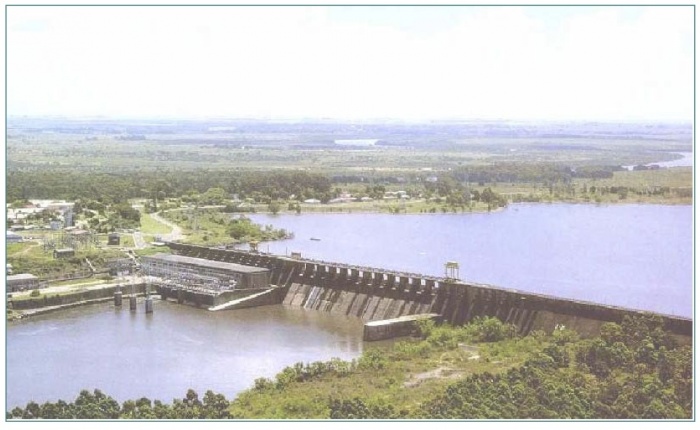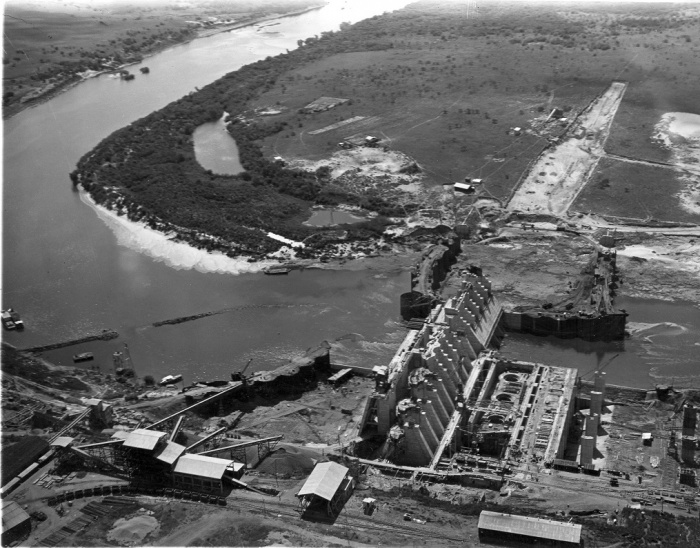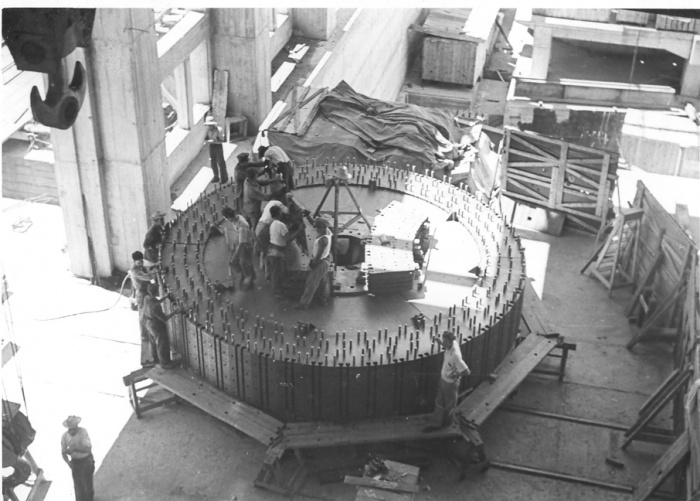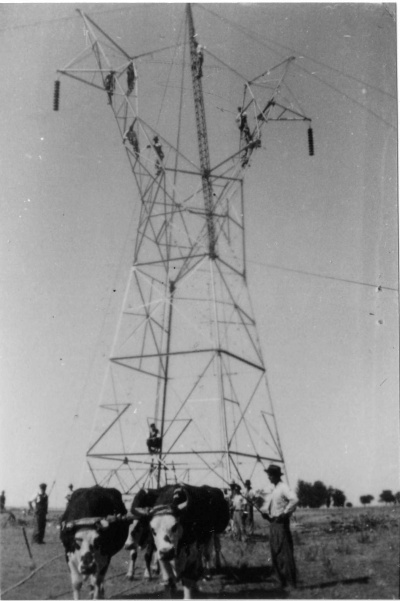Milestones:Rincón del Bonete, 1945
Rincon del Bonete Hydroelectric Plant and Transmission System, 1945
In December, 1945, much-needed hydroelectric power began flowing from here to other parts of Uruguay. World War II had interrupted the work begun by a German consortium, but Uruguayan engineers reformulated and completed the project using United States-supplied equipment. The large artificial lake spurred further Rio Negro electrification; availability of abundant, clean hydroelectricity was a turning point in Uruguay's development, quality of life, and engineering profession.
(The plaque may be viewed on the outside wall near the entrance to the Rincon del Bonete Powerhouse, which is still in operation. GPS coordinates are: 56° 25' 18.6" S, 32° 49' 55.5" W. The plaque will be affixed to an outside wall, where the frequent public/student touristic/educational tours make a stop.)
Rincon del Bonete: First Stage of the Electrification of the Negro River
In 1904, the Uruguayan engineer Victor Soudriers, responsible for the construction of a bridge over the Rio Negro, gained direct knowledge of the potential of the waterway for navigation and power generation. The bridge was finally built in the "Picada de los Ladrones" ("The Robber's Crossing") in the middle-high course of the river.
However, necessary studies, level and flow measurements, installation of river gauges and the consolidation of an appropriate legal framework took many years. Political milestones included the Acts for the establishment of the Directorate of Hydrography and the public utility (Usinas y Trasmisiones Electricas, UTE) for generation and distribution of electricity.
Two projects by J. G. White (London, 1912) and then another one by the U.S. firm Ulhen (1916) were discussed at length. But they were limited in scope and did not materialize. These were projects for the upper-middle course of the river. In 1923, French Prof. Kalbermatten drafted another plan for hydroelectricity generation in the middle course of the river. The exploitation of the Rio Negro for hydroelectric generation attained national significance around 1930. Numerous technical articles in the "Revista de Ingenieria" (published by the National Engineers' Society) testify to the interest and technical, economic and political debate spurred by this issue. Critics argued that although Uruguay did not have any sources of coal or oil, the cost of the work could be justified only to the extent that electricity demand was expected to increase, since the projected installed capacity was greater than present demand. Finally, by 1933 the government, convinced of the feasibility of the venture (after consultation with the University and the Engineer's Association) hired German Professor Ludin to develop a project plan and specifications for international bidders. The President, Gabriel Terra, was instrumental in the concretion of the project. In recognition, years later, in the 1970s, the Dam was renamed in his honor.
This finally resulted in the construction of the dam at Rincon del Bonete, in the middle course of the river. [In Spanish "bonete" means a round hat, almost like a bag. It refers to the particular form of this river's meander, which are generally called "rincon," and probably explains the orign of the name.]
The largest project in the history of Uruguay
The estimated project cost was more than 7 million Pounds Sterling, plus the local expense of expropriation of the land to be flooded. This was a very significant percentage of GNP, especially considering that the country's population at that time was just below 2 million people. An international bidding was conducted and there were two offers: one from Germany (A consortium led by Siemens, Berlin) and one from Czechoslovakia (Skoda Industries, Pilsen). The alternative offer from Siemens was accepted and the contract was signed in April, 1937.
It was an ambitious and visionary project: 128 MW surpassed the country's demand and there was absolutely no experience in the country with the HV necessary for the 230 Km long lines of the trasnmission system. The Kaplan turbines specified were an early example of pushing that technology to higher levels, as was the case in Shanon, Ireland (http://www.ieeeghn.org/wiki/index.php/Milestones:Shannon_Scheme_for_the_Electrification_of_the_Irish_Free_State,_1929)
On 18 May 1937 in the midst of a civic, popular party in the nearby city of Paso de los Toros ("The Bulls' crossing"). the construction work began.
Importance to the electrification of Uruguay and Latin America
Since the Rio Negro is a lowland river, and given the irregularity of rainfall patterns in the region, it was necessary to create a large artificial lake, which at the time was the largest in Latin America, and one of the largest in the world. Its total volume allows the plant to operate for four months, even without any flow contributions from the river's tributaries; two or three additional powerhouses could be built downstream, taking additional advantage from the flow regulation capabilities of that artificial lake (1,100 square Km).
The dam, literally in the center of the country, was at a great distance from the primary center of electrical consumption consisting of the capital city Montevideo and its surroundings. This required the construction of a major HV transmission system. The greater meaning of the project, however, is that a whole country, without availability of fossil fuels, pioneered the way into hydropower, breaking years of dependence on costly imports of coal and oil.
Difficulties during World War II
After September 1939, the British Navy prevented the loading and transport of electromechanical equipment from Germany. Parts were manufactured and ready to ship in Mediterranean ports, some of which had already been partially paid. The Uruguayan government started feverish negotiations with England, to allow the parts to board and cross the Atlantic Ocean. Nevertheless, the English government refused to allow shipping of any parts of the turbines, transformers, cranes, gates, etc., thereby completely stopping the advance of the electromechanical assembly.
Search for New Equipment in the United States
The Uruguayan government created a special institution for managing the project and the works: the Administration of the works in Rio Negro, "RIONE." RIONE, under the leadership of Technical Director Mr. Luis Giorgi, was already taking precautions and adapting construction details in order to continue with the civil works despite missing elements such as gates, closure panels, etc. In 1941, Mr. Giorgi began negotiations with the United States of America, which had not yet entered World War II, and was the only country able to manufacture and supply the electromechanical equipment. After the Japanese attack on Pearl Harbour, Hawaii, in December 1941, the project was further complicated by the difficulty of obtaining strategic materials such as steel and copper.
Uruguay broke relations with Germany in April 1942 and the contract with the German consortium was canceled in May 1942 by decision of the Presidency of the Republic. In July, the last remaining German workers left Uruguay. A loan was obtained from Eximbank (Washington, D.C.) to finance the necessary American equipment. An additional agreement was signed that permitted the manufacture and export of heavy equipment, amid strict war restrictions. (see Agreement_1942.pdf)
The Project Reformulation and Adaptation to the Best Technology Available at the Time in the United States
The original project was designed according to German standards, e.g. frequency 50 Hz, metric units. Thus, the construction of the powerhouse, intake gates, draught tubes, mounting of the embedded parts of the turbines, etc. were being completed for machines that would never come. RIONE appointed a team of young engineers, recent graduates, to acquire specialization in the United States and work to amend the project. The program included technical visits and traineeships in factories and plants, while working with Harza Engineering (Chicago) in the adaptation and reformulation of the project. Any dialogue or consultation with German technicians was forbidden by the war conditions.
Among many other specifications, the speed of rotation of the units was altered from 136.4 to 125 rpm and the alternators voltage was changed from 7 kV to 13.8 kV. Several modifications were needed to adapt the already build concrete structure and foundations to the Morgan Smith turbines, General Electric generators and Westinghouse high voltage equipment. The transmission system was modified significantly. Unit step-up transformers were changed from a complete bank to a set of three monophasic units, and the rated voltage was lowered from 170 kV to 161 kV.
Importance for Engineering profession in Uruguay
During 1934, while Luis Giorgi was Dean of the Faculty of Engineering at the University of the Republic in Montevideo, the curriculum was modified to create a major in Industrial Engineering. This degree included the electrical and mechanical knowledge required to address the engineering issues related to hydropower generation. When the war halted the works of the German consortium, the first industrial engineering graduates were commissioned to USA to work on the project and then complete the dam. Those professionals were later professors and also acted as consultants for subsequent hydroelectric works, notably the Salto Grande Project. Among them were Mr. Carlos Rezzano as chief of the mission; Mr. Antonio De Anda, who specialized in mechanical issues; Mr. Franco Vazquez Praderi in the electrical field (he was a young AIEE member at that time and later became Life Senior member); and Mr. Victor Campistrous and Mr. Dal Monte, who were responsible for erecting the entire transmission system.
On-site Installation
While the issues with the electromechanical equipment were being solved in USA, RIONE and its Uruguayan engineers were moving ahead and completing the civil works. Everything was ready for mounting the first unit when it arrived in the port of Montevideo in January 1945.
All tasks in the construction, installation, testing and commissioning of the system were the responsibility of solely national labor, trained and supervised by the engineers who had specialized in the USA. Only two American inspectors, one from GE (alternator) and another one from Morgan Smith (turbine), were present in Uruguay, in order for the installation to qualify for warranty. Unit #2 was the first to be ready in December of that year.
Transmission System
The construction of the first high voltage line (230 km) was performed entirely by Uruguayan engineers and the workers trained by them, from August 1944 to November 1945. Although the technology was completely new, it performed as expected and there was no loss of life during the construction. The receiving end at Montevideo was moved to a new sub-station (North) on the outskirts of the city, rather than connected to the switchyard area of the existing thermal plant. A ring of underground cables was built (31.5 kV) to distribute the energy throughout the city, as well. Completion of the ring was delayed during the war years, because of a scarcity of materials. Later, a second transmission line from Rincon del Bonete gave the system enhanced availability.Many HV Transmission system studies were performed for the setup, first in Westinghouse's analog network analyzer and later at MIT. As a result two 20 MVAR synchronous condensers were added to the new sub-station "Norte" (North).
Commissioning of the First Unit
The project had suffered years of delays because of the Second World War. In Montevideo, thermal generation was insufficient to cope with demand as war requirements in Europe meant that good quality fuel (coal from England) was scarce and expensive. Years of using poor quality fuels, including agricultural residues, had complicated the operation of the city's boilers, and maintenance works had long been deferred. To be able to maintain thermal units, as soon as the first hydroelectric unit in Rincon del Bonete was ready, a decision was made to split the network in Montevideo in order to connect some of the load directly to the new system.
This was accomplished in the early hours of December 21, 1945. Victor Soudriers - who had conceived the idea in 1904 and fought for the constructions for many years - was called to operate the main breaker. At the hydroelectric plant, the official inauguration was on December 26; senior officers from the Uruguayan government and the U.S. ambassador gave speeches at the opening ceremony.
Benefits for the Whole Country
Electricity generation far exceeded even the most optimistic forecasts. No longer limited by the generation capacity, demand growth reached double-digit percentages annually during the first decade of operation. The whole country benefited from the abundance of cheap and clean electricity, constituting a factor for national development and welfare. The generating Units in Rincon del Bonete worked with capacity factors from 0.55 to 0.60 and above for more than 45 years. At the end of the 20th century they were renovated and are still operating as an important part of the country's electrical network. Years later, the official name of the instalations was changed to "Gabriel Terra" who, as the government's leader, was instrumental in the decision to build them.
Further Development of Hydropower in Uruguay
The fourth and last unit of "Rincon del Bonete" entered service in 1949; also the second trasnmission line to Montevideo. In April 1950 all the installations and the responsability for their operation were transferred to the public utility "UTE." Two other powerhouses were later built downstream of Rincon del Bonete: Baygorria (100MW) in 1960 and Palmar in 1982 (330 MW). For many years, hydro generation constituted 80% to 90% of the electric energy matrix of Uruguay. In 1946, when Rincon del Bonete had just started to generate electricity, an international agreement was signed and approved with the Republic of Argentina for the construction of Salto Grande dam. The agreement resulted in the hydroelectric development of the Rio Uruguay, the boundary between the two countries. This was an ambitious bi-national project (1890 MW) that began generating electricity in 1979.
EPILOG: The Flood of 1959
In April 1959, after two months of heavy autumn rains, an extraordinary flood of the Rio Negro occurred that greatly exceeded the spillway capability (greater than the expected 10,000-year flood). The water overflowed the dam, despite efforts to increase its height by one meter with cement bags and the partial blast of a lateral earth dam to reduce the overflow. Downstream, the power house was flooded and the electrical equipment was damaged, forcing its subsequent rewinding.
The civil structure of the dam gave proof of its excellent construction, as it supported the overflow without experiencing problems. The downstream towns of Paso de los Toros and Mercedes, and the works on the new dam Baygorria were saved from total destruction because Rincon del Bonete acted as a regulator: containing the great flood, attenuating material losses and avoiding loss of life.
The plant began generating electricity again in March 1960 after the installation of new windings in the alternators. At the end of the 20th century, and after almost 50 years of operation, the turbines and generators were replaced, simultaneously rising the rated power from 128 to 152 MW.
Importance of the Achievement in Rincon del Bonete
Besides the significance of using state of the art technology in southern South America in difficult wartime, the Rincon del Bonete Project marked a milestone in the history of the country. In Latin America, Uruguay was a premier example of a country that opted completely for hydraulic, renewable energy ("white coal"), thereby eliminating the necessity of costly imports of fuel. The project was completed thanks to the initiative and achievement of Uruguayan engineers and workers, who had to reformulate the original project and procure the necessary material and educational resources to finish the work. Their success was an important factor in reaffirming the sovereignty of the country and the quality of education of its engineers.
Bibliography
Giorgi, Luis (RIONE): "Hydroelectric Powerhouse at Rincon del Bonete, Negro River" presented at the First Pan-american Congress of Engineering, Rio de Janeiro, 1949 and also reproduced by the Uruguayan Engineering Review (in spanish)
Media:RIONE_description_1949.pdf
Sorensen, Kenneth "Hydro-electric Development in Uruguay" Water Power, Nov 1951
UTE: Technical Data for the Lake, Dam and Generators
http://www.ute.com.uy/pags/institucional/terra.htm
Morales, Franklin; "The beginnings of our Hydro-generation" Book published by UTE, 1999 (in Spanish)
Esther Ruiz: "Memories of a Silent Profession: History of Engineering in Uruguay" , published by the Engineering School of the University of the Republic, 1999 (in spanish)
Morales, Franklin: "An uruguayan epic" published by "EL PAIS" set 2005 (in spanish)
http://www.elpais.com.uy/Suple/QuePasa/05/09/17/quepasa_174250.asp
from US Dept. of State files
Approval spanish.jpg
Rincón del Bonete Hydroelectric Plant, 1937-1949
Proposal
Milestone-Proposal:Rincon del Bonete Hydroelectric Plant and Transmission System
<googlemap version="0.9" lat="-32.833515" lon="-56.423206" zoom="10" width="300" height="250" controls="small"> -32.833515,-56.423206 Rincón del Bonete Hydroelectric Plant, Uruguay </googlemap>



